Embarking on creative projects often involves adding appliques to fabrics, providing a burst of personality and style. A pertinent question arises: Can you use fabric glue on appliques? The answer is a resounding yes.
Fabric glue is a versatile and efficient adhesive formulated explicitly for fabrics, making it an ideal choice for attaching appliques.
This introduction sets the stage for exploring the nuances of employing fabric glue in the realm of applique crafting, addressing considerations such as fabric compatibility, proper application techniques, and the balance between convenience and durability.
Let’s unravel the possibilities of seamlessly fusing fabrics and appliques through the artful application of fabric glue.
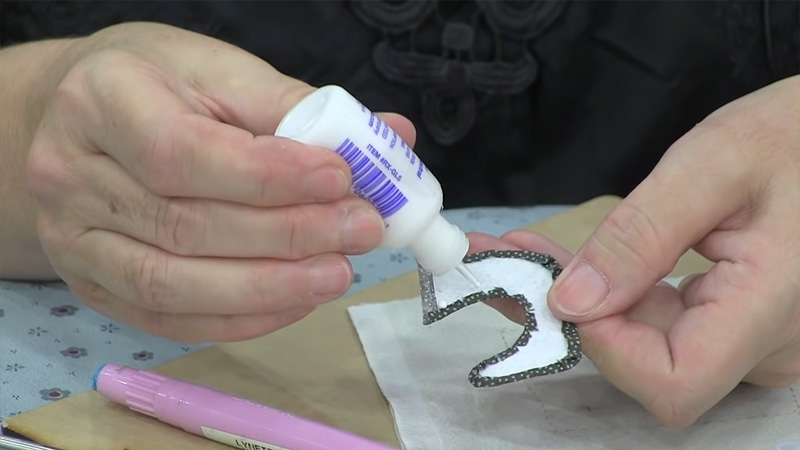
Can You Use Fabric Glue on Appliques?
Yes, you can use fabric glue on appliques, which is a convenient and effective way to attach them to fabric.
Fabric glue is a versatile adhesive explicitly designed for use with fabrics, making it suitable for various applications, including attaching appliques.
Here are some important points to consider when using fabric glue on appliques:
Fabric Compatibility
When selecting a fabric glue, consider the materials of both the base fabric and the applique. Fabric glues are often formulated for various fabrics, but certain types may be more suitable for specific materials.
For example, if you’re working with delicate fabrics like silk or satin, opt for a gentle fabric glue that won’t leave visible residue.
Clean and Dry Surfaces
Proper surface preparation is crucial for a strong bond. Ensure that the base fabric and the applique are free from dirt, oils, or moisture.
Before applying the glue, you can pre-wash and iron the fabrics to remove any residues or wrinkles that might interfere with the adhesive.
Positioning
Take time to plan the placement of the applique on the fabric before applying the glue. Once the glue is used, it begins to bond immediately, making repositioning challenging.
Use measuring tools or templates to ensure accurate placement, especially if you are working on a project that requires precise alignment of multiple appliques.
Apply the Glue
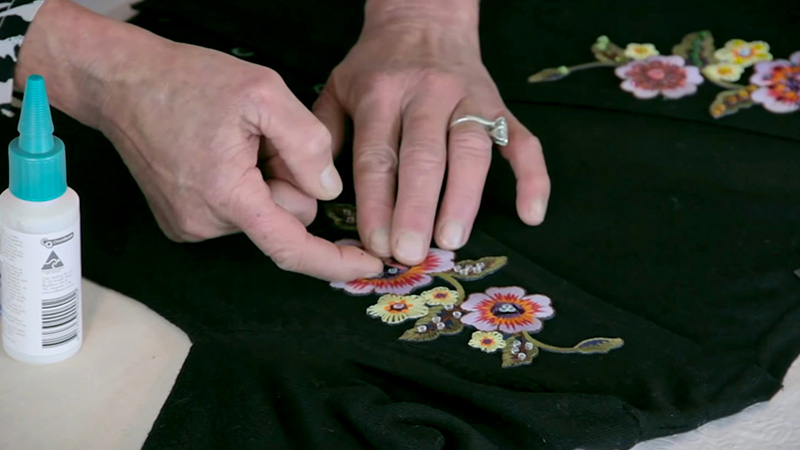
Follow the guidelines on the fabric glue packaging for the best application. Some fabric glues come in squeeze bottles with applicator tips, allowing you to control the amount and distribution of the adhesive.
Apply a thin, even layer to the back of the applique, covering the edges.
Press and Bond
Once the glue is applied, gently press the applique onto the fabric, ensuring complete contact between the surfaces.
You can use your hands or a clean, flat object to apply even pressure. Avoid using excessive force, as it may distort the shape of the applique or squeeze out excess glue.
Drying Time
Respect the recommended drying time specified by the fabric glue manufacturer. Drying times can vary, and humidity and temperature may influence the process.
It’s essential to fully allow the glue to cure to achieve a solid and lasting bond. Patience during this phase will contribute to the overall success of your project.
Washability
Check the fabric glue label for information regarding the washability of the bonded applique. Some fabric glues are designed to withstand washing, but others may require more delicate care.
If the project involves garments or items that will be laundered, choose a fabric glue labeled as washable.
Alternative Stitching
While fabric glue provides a convenient solution, you can enhance the durability of the applique attachment by reinforcing it with stitching.
Choose a complementary thread color and sew around the edges of the applique using a straight or decorative stitch.
This adds a personalized touch and ensures that the applique stays securely in place, even after multiple washes.
How to Apply Appliques With Fabric Glue? Step-By-Step Guide
Applying appliques with fabric glue is simple and convenient, offering a no-sew alternative for adding decorative elements to fabrics.
Here’s a step-by-step guide on how to apply appliques using fabric glue:
Gather Materials
Before embarking on your applique project, ensure you have all the necessary materials. Consider using a ruler or measuring tape to ensure precise placement along with the appliques and fabric glue.
Templates can be handy for achieving a consistent layout, and a flat object, like a book or piece of cardboard, can aid in applying even pressure during the bonding process.
Prepare the Fabric
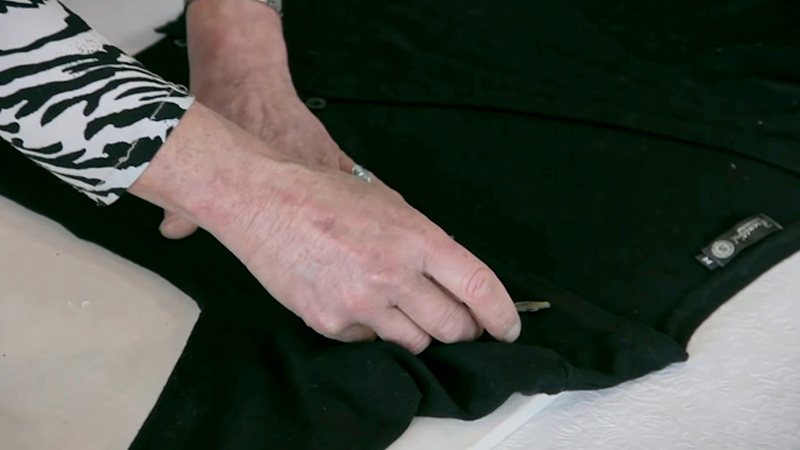
Taking the time to prepare your fabric correctly is a crucial step for successful applique attachment. Ensure that the fabric is clean by washing and drying it according to the care instructions.
Iron out any wrinkles, as a smooth surface will facilitate a better bond between the fabric and the applique.
Arrange and Plan
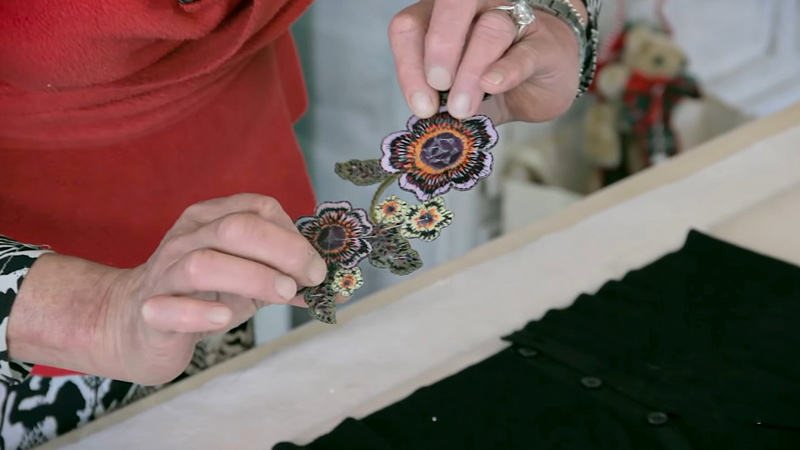
Laying out your fabric and appliques before applying glue allows you to visualize the final design. Consider the overall composition, spacing, and alignment of multiple appliques.
Measuring tools and templates come in handy here, ensuring accuracy and symmetry in your arrangement.
Apply Fabric Glue
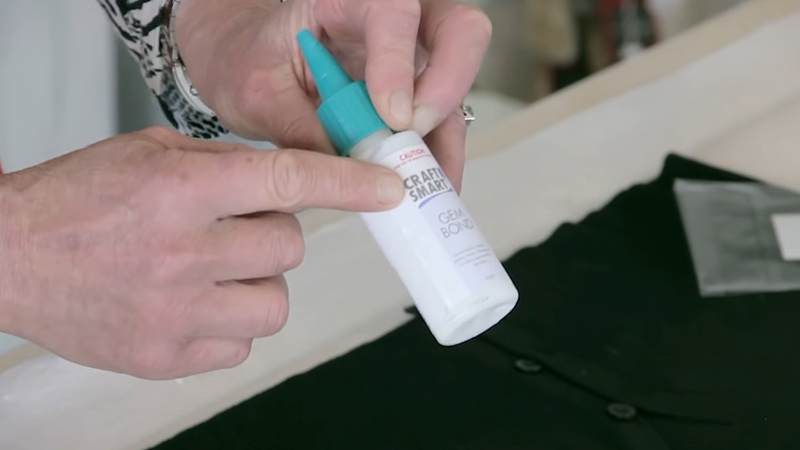
Following the fabric glue packaging instructions is essential for achieving the best results. Most fabric glues come with applicator tips or squeeze bottles, offering control over the amount and distribution of the adhesive.
Apply a thin, even layer of fabric glue to the back of each applique, ensuring that the edges receive sufficient coverage.
Position the Applique
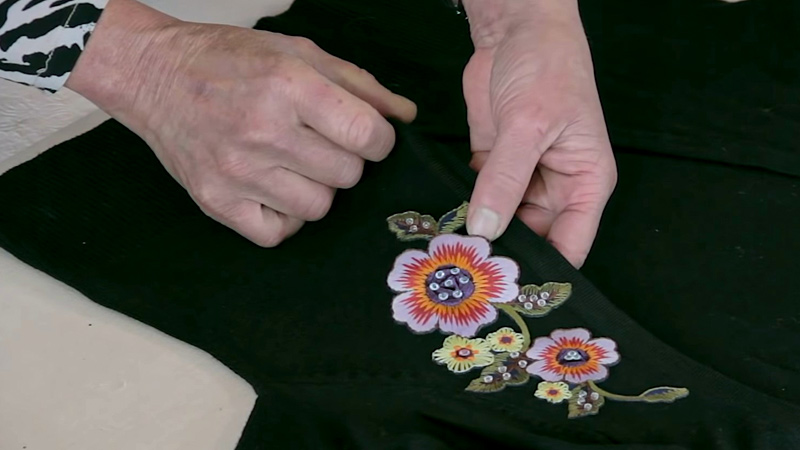
Once the fabric glue is applied, carefully position the applique onto the fabric according to your pre-planned layout.
Take your time aligning it precisely, as adjustments may be challenging once the glue starts to bond. Press the applique onto the fabric, applying even pressure to create a strong initial bond.
Smooth Out Air Bubbles
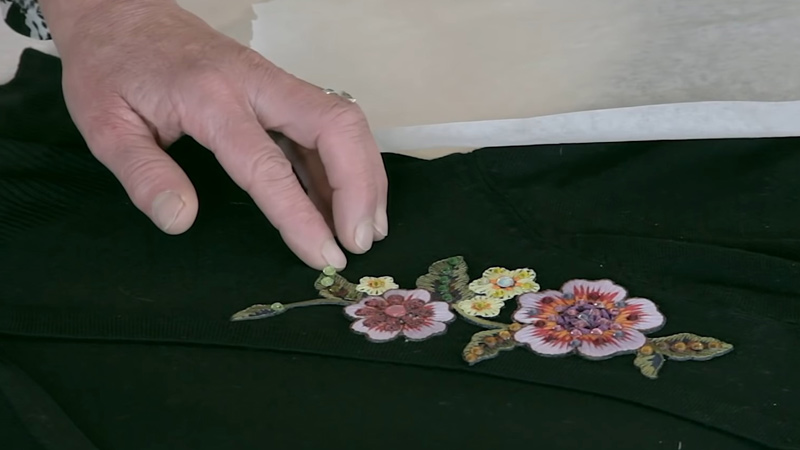
Inspect for any air bubbles or wrinkles after pressing the applique onto the fabric. Smooth them gently with your fingers, ensuring a seamless and flat attachment. Be cautious not to distort the shape or alignment of the applique during this process.
Press and Hold
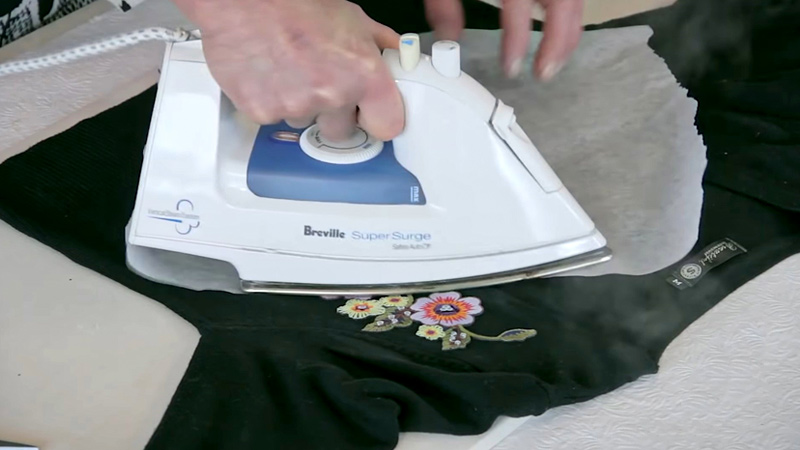
Hold the applique in place for a few moments to allow the fabric glue to initiate bonding. While the initial bond occurs quickly, the glue may require additional time to set fully.
Following the recommended drying time on the fabric glue packaging is essential for achieving a durable and long-lasting bond.
Allow for Drying Time
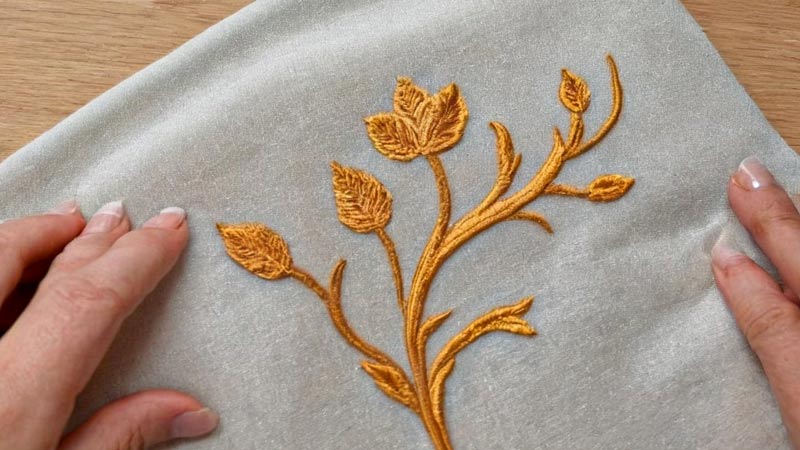
Patience is critical during the drying phase. The drying time can vary depending on the fabric glue used and environmental conditions. Avoid moving or disturbing the applique during this period to prevent potential displacement.
Optional: Reinforce with Stitching
To enhance your applique’s durability and aesthetic appeal, consider reinforcing it with stitching.
This optional step involves sewing around the edges of the applique using a complementary thread color.
Apart from adding a decorative touch, stitching provides extra security, especially for items that require regular washing.
Check Washability
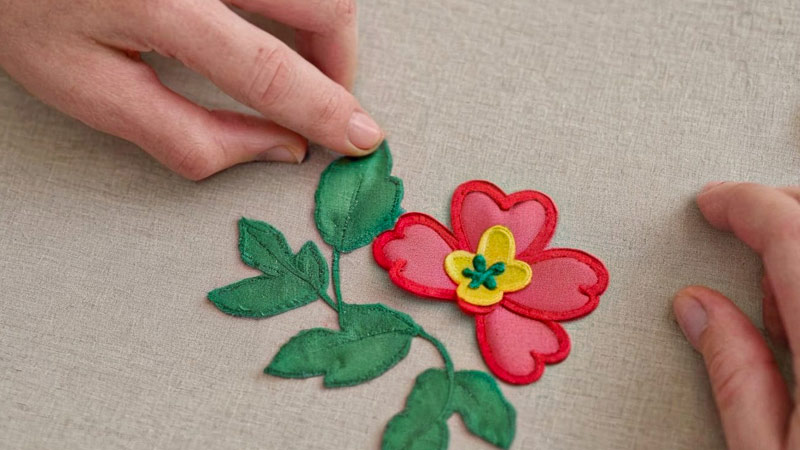
Before incorporating your fabric into daily use or laundering, consult the fabric glue’s label to confirm washability. Some fabric glues are designed to withstand washing, but others may have specific care instructions.
Following the recommended washing and care guidelines ensures the longevity of the bonded applique.
How to Attach Applique Without Sewing?
Attaching applique without sewing is a convenient and accessible method, perfect for those who may not have sewing skills or prefer a quick and easy solution.
Fabric glue, fusible web, and adhesive backing are popular alternatives for a no-sew applique application.
Here’s a step-by-step guide on how to attach applique without sewing:
Gather Materials
Before diving into your applique project, ensure you have all the essential materials within reach.
Alongside the appliques and fabric glue, consider obtaining fusible web or adhesive backing, the fabric destined for the appliques, and supplementary tools such as measuring implements, templates for precision, and a flat object for effective pressing.
This thorough preparation sets the stage for a seamless crafting experience.
Prepare the Fabric
The groundwork for a successful no-sew applique lies in the meticulous preparation of your fabric.
Guarantee its suitability by ensuring it’s clean, thoroughly dry and devoid of wrinkles or undesired debris.
A preliminary round of pre-washing and careful ironing transforms the fabric into an ideal canvas, boasting a smooth surface conducive to optimal adhesion.
Arrange and Plan
Invest time meticulously laying out your fabric and strategically placing the appliques according to your envisioned design.
The careful arrangement becomes especially crucial when dealing with multiple appliques or a specific design.
Leverage measuring tools and templates to achieve accuracy, ensuring your envisioned layout translates seamlessly onto the fabric.
Choose Attachment Method
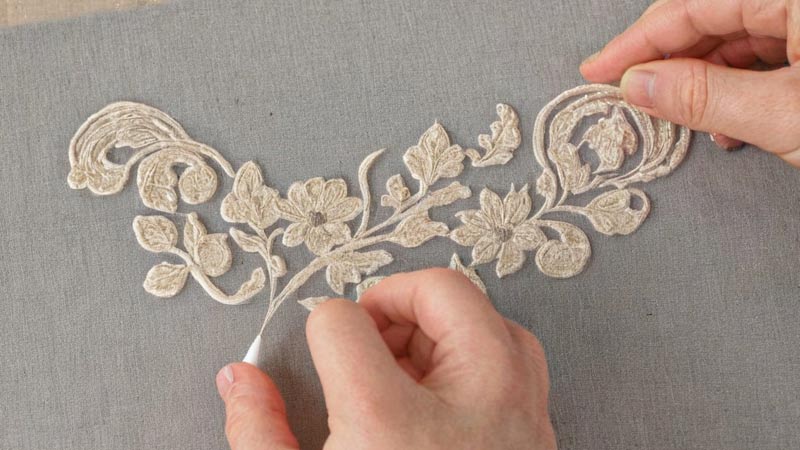
- Fabric Glue: Delve into the application process by adhering to the guidelines furnished on the fabric glue packaging. Apply a slender, even layer of fabric glue to the back of each applique. Execute a thoughtful alignment according to your preconceived layout, pressing the applique onto the fabric with a uniform force.
- Fusible Web: Precise execution characterizes the use of fusible web. Cut a piece more minor than the applique and strategically place it on the back. Harness the heat of an iron to initiate adhesion, adhering strictly to the product’s instructions. Allow the fusible web to cool before advancing further.
- Adhesive Backing: Simplify the process by peeling off the protective backing from the adhesive. Align the applique meticulously on the fabric before applying firm pressure to secure it. Smooth out any potential air bubbles or wrinkles with the dexterity of your fingers.
Smooth Out Air Bubbles
Post-application, perform a meticulous examination for any lurking air bubbles or wrinkles.
Employ a gentle touch to smooth out these imperfections with your fingers, ensuring a flawless surface without compromising the integrity of the applique’s shape.
Press and Hold
The pivotal step of pressing and holding demands your patience. Invest a few moments to keep the applique in place firmly, allowing the fabric glue and adhesive backing to initiate bonding seamlessly.
The process is swift for fabric glue and adhesive backing, while fusible web requires additional time for cooling and setting.
Allow for Setting Time
Respect the uniqueness of each attachment method by adhering to the recommended setting or drying time.
Fabric glue and adhesive backing typically demand a relatively short period, while the fusible web necessitates additional time to cool and set, solidifying the bond between applique and fabric.
Optional: Reinforce with Stitching
Delve into the realm of optional enhancements by reinforcing your applique with stitching. Beyond the practical purpose of adding durability, the stitching introduces an ornamental element.
Choose a complementary thread color and stitch around the edges, providing both visual appeal and additional security, especially for items expecting frequent washing.
Check Washability
Conduct a final evaluation before subjecting your fabric to laundering. Scrutinize the product labels for details on washability, ensuring that the applied applique, whether through the fusible web or other means, aligns with specific care instructions.
This thorough inspection guarantees the longevity of your crafted masterpiece.
FAQs
Can fabric glue be used on all types of fabric for appliques?
Fabric glues are generally designed to work with a variety of fabrics. However, it’s advisable to check the specific glue’s compatibility with the base fabric and applique material.
Is fabric glue a permanent option for attaching appliques?
Fabric glue provides a strong bond, but permanence may vary. Some fabric glues offer washable bonds, while others may be more permanent. Always check the product label for details.
Can you reposition the appliques after using fabric glue?
Once fabric glue is applied, repositioning can be challenging. It’s crucial to plan the placement carefully before adhering to the applique to avoid any adjustments later.
Is stitching necessary if fabric glue is used to attach appliques?
While fabric glue alone provides a secure attachment, stitching around the edges can enhance durability and add a decorative touch. It’s optional and depends on the desired outcome.
How long does it take for fabric glue to dry on appliques?
Drying times vary among fabric glues. Follow the specific instructions on the glue’s packaging, but generally, fabric glue can start bonding quickly, with complete drying taking a bit more time.
To Recap
Utilizing fabric glue on appliques is a versatile and accessible alternative, offering a seamless bonding solution without sewing.
This adhesive method simplifies the attachment process and provides a strong and durable bond when applied correctly.
The convenience of fabric glue makes it an excellent choice for various crafting projects, allowing individuals of all skill levels to embellish fabrics easily.
Whether adding a decorative touch to clothing, accessories, or home decor items, fabric glue empowers creative expression without the constraints of traditional stitching.
Embracing this technique opens possibilities, where appliques can be effortlessly and securely affixed to fabric surfaces.
Leave a Reply